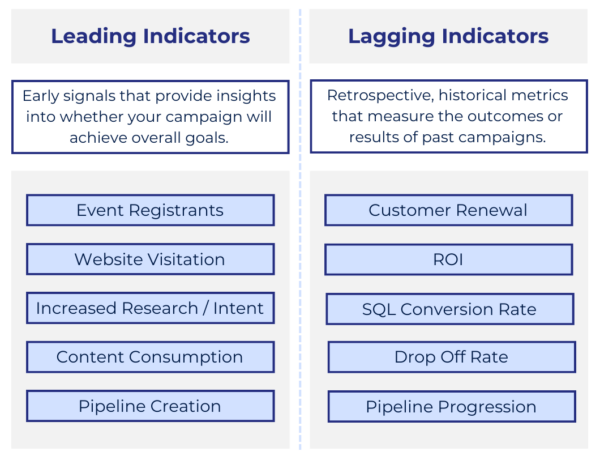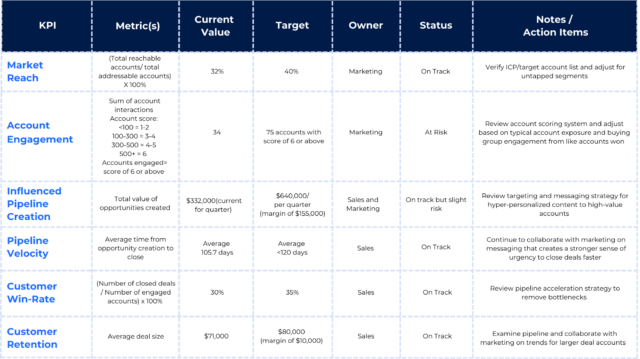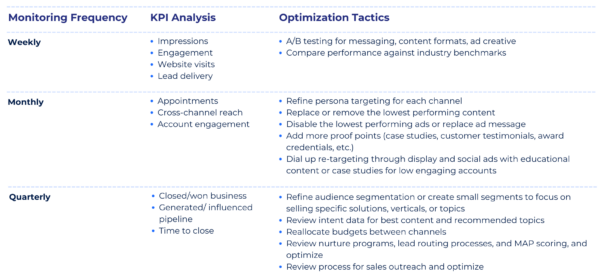
Repeat after us: real-time strategy measurement and optimization are fundamental to campaign success.
Gartner research shows that only 29% of CMOs believe they have the necessary budget to successful execute their campaign strategies, supporting the idea that B2B marketers will be forced to rely more heavily on data and account insight to ensure they’re maximizing their budgets and optimizing their campaign strategies accordingly. A unified multi-channel account-based marketing (ABM) strategy provides the best view of account progression through the buyer’s journey, making it easier to identify trends, adjust strategies, and make data-driven decisions that will improve campaign effectiveness rather than waiting until the end to realize what went wrong.
Ready to start implementing a better measurement framework that enables you to visualize campaign performance and optimize your approach in real time? Read on to learn how.
What is Campaign Optimization?
Campaign optimization is the ongoing process of refining marketing strategies and tactics. It involves measuring metrics and key performance indicators (KPIs), then making informed adjustments to target accounts, messaging, and channels. The aim is to ensure that campaigns not only achieve business objectives, but also stay relevant to your audience. By applying best practices in both optimization and measurement, marketers can pivot swiftly, maximize ROI, and expand their reach to target accounts.
Optimization and measurement work together in a feedback loop, driving continuous improvement and informing decision-making. With clear metrics and KPIs, marketers can assess ABM campaign performance in real time, enabling quick strategy adjustments. This data-driven approach helps teams identify what’s effective, refine their targeting, tailor messaging to key accounts, and adjust their marketing mix channel strategy. The result is stronger engagement and alignment with overall business goals.
Common Challenges for Campaign Optimization and Measurement
Marketers face a number of hurdles when it comes to accurately measuring and demonstrating their ABM performance. While some of these challenges stem from inherent complexities with pinpointing and attributing the success of marketing campaign initiatives to specific high-value accounts, others relate to more general obstacles impacting the B2B marketing space.
The bottom line: growth is harder, and budgets are tighter. Marketers can no longer rely on the promise of additional budget when times get tough. You need better visibility into campaign progression to identify areas of optimization to ensure you’re engaging accounts more effectively than your competitors.
Here’s why ABM measurement has gotten harder:
- The decision-making process has changed. Buying cycles are longer and involve more touchpoints across multiple channels. You used to be able to focus your digital marketing efforts on one or two key decision-makers; now, you need to influence members of the entire buying committee made up of representatives from different departments, titles, and seniorities. Compounding these challenges are market uncertainties and competitive forces that make it even more difficult to get a group consensus that a problem exists and drive urgency to solve it.
- Lack of education. Nobody teaches you how to measure the customer lifecycle effectively, which is essential for predicting results confidently and implementing strategies to optimize underperforming results. This lack of knowledge leads to less confidence in being able to materially affect the final impact.
- Data is more disseminated. The data needed to inform your measurement efforts is cumbersome and often siloed, making it difficult to obtain and connect into a single view. It can be difficult to know what data you need and whether the data you have is even accurate when facing data silos.
- Increased expectations from internal teams. Marketers face external pressures, both vertically (i.e. executives) and horizontally (i.e. sales), to not only be in control of the buying journey throughout all campaigns within your ABM strategy, but to also meet their constant expectations to show higher ROI faster.
9 Best Practices for More Successful Campaign Optimization and Measurement
Given the challenges B2B marketers face today, including tight budgets and shifting market dynamics, it’s critical to be agile, logical, and data-driven to maximize results.
Let’s break down nine best practices that will empower you to optimize your campaigns effectively and enhance your measurement strategies.
1. Pay Attention to Both Leading & Lagging Indicators
Company size, growth stage, and industry marketing benchmarks will all impact how you align your campaign goals. Still, understanding foundational marketing and sales metrics, like customer acquisition cost, conversion rate, and deal velocity, and how each channel impacts them, reveals how successful your channels are in terms of engagement and where you can maximize results.
Breaking your marketing and sales metrics down into their leading and lagging indicators provides a deeper understanding of how your content and messaging is performing across campaigns.
For example, here’s our approach to leading vs. lagging indicators.

While leading indicators contribute to your goals, they can fluctuate from campaign to campaign and month over month. On the other hand, lagging indicators take longer to measure and need more time before you can optimize against them. Since it takes time to see campaign impact on your lagging indicators, use your leading indicators as a sign as to whether you’re on the right track. You’ll want to gather historical data for both, but lagging indicators will be more quantifiable after going through your sales cycle two or three times.
2. Set Individual Channel KPIs That Roll Up into Campaign KPIs
Measuring campaign performance isn’t one size fits all. It’s important to set goals and measure success individually within each marketing and advertising channel. Success within an email program looks drastically different than success within a display program, but they’re all indicators of the overall health and success of your campaign.
Ideally, you measure each program on an ongoing basis with their specific KPIs, gather your findings into a monthly report, and tie all activities together into a full campaign readout. This helps you understand which channels are performing the best and how those channels impact lead scoring.
Here’s how we recommend aligning specific channels with relevant KPIs.

Understanding the success of your multi-channel ABM strategy requires you to dive deeper into your data (which is hopefully already in a single, holistic view—more on that below) to determine how each channel impacts pipeline and revenue on an individual and collective campaign basis. With your findings, you can optimize each channel with by creating content that aligns with your channel KPIs. This not only supports your marketing strategy but but also fuels conversations around how these metrics contribute to higher quality interactions, ultimately benefiting your company’s bottom line and return on investment (ROI).
3. Measure Lead Quality During Nurture Stages of the Funnel
Throughout the nurture process, measure the quality of each lead you’re nurturing and any disqualification trends you identify. If you’re receiving out-of-market leads or a large drop during the nurture stage, analyze your initial targeting, channel, and content strategies, and optimize each strategy with your findings. You may also need to adjust timelines per channel, as algorithm and marketplace conditions may impact buyer behavior and the visibility of your campaigns.
4. Optimize KPIs for Personas in the Buying Committee
Your KPIs aren’t just a foundation for goals or focus to optimize your channels toward—they’re reactive to who you’re targeting in the first place. Buying committees aren’t set in stone and may change their initial point person or decision-makers for a variety of reasons. Ideally, your ABM KPIs are aligned with each member of the buying committee’s role, as everyone’s impact on buying decisions is different. If you’re looking to get your foot in the door with new, inbound leads, adjust your scoring model to focus on the people who will take that initial call versus a buying committee member who will just have to sign off on the partnership.
A best practice to consider is to measure the initial lead’s engagement with your engagement benchmarks, then drop the benchmark by 10% for corresponding buying committee members since they’re not as invested yet. Segment your findings according to similar accounts within the funnel and compare their behaviors with current and previous clients to consider what their buyer journey may look like. This practice will eventually plot out a timeline for leads initiating contact with or responding to a salesperson.
5. Prioritize Your Potential Advocates
When you think about how to divide your campaign efforts, prioritize the buyer personas who will advocate for you. If you can deliver enough content and generate enough engagement with the personas who carry the most influence during the decision-making process, they’ll do the work for you to convince the rest of the buying committee that you are the right partner and tool to help them achieve departmental and company goals. Once you identify your advocates, consider their persona and optimize future campaigns around similar demographics.
Consider what forms prospects fill in as part of their buyer journey. High-intent forms include a demo request or contact form, while low-intent forms may be a webinar registration or eBook download. While leads can skip around funnel stages, moving from TOFU to BOFU content, they may potentially stall. One way to avoid sudden jumps around content is to map out content that easily complements each other. You can also take a more technical approach by A/B testing CTA copy, button placement on a landing page, and reading suggestions. Keep in mind that, with A/B testing, you only want to test one element at a time and measure it for a set period of time before optimizing everything across your website.
6. Integrate Feedback Loops with Sales and Marketing
Achieving success in ABM depends on offering a unified and tailored experience for buyers at every stage of the sales cycle, including their engagements with the sales team. By implementing feedback loops, both marketing and sales can stay aligned and exchange valuable insights, ultimately improving the effectiveness of your ABM strategies.
Here are key aspects to consider when considering how to align sales and marketing to drive ABM success:
- Schedule regular meetings between sales and marketing to review ABM metrics, share feedback, and address challenges. These meetings foster collaboration, with both teams understanding their role in driving ABM success. Designate advocates who are open to collaboration and have a strong understanding of ABM principles to ensure a unified view of success.
- Establish shared goals and KPIs that both teams can work toward, focusing on key outcomes like sales cycle progression, customer growth, and contract value. A unified scorecard ensures alignment, helping both teams target the right accounts and optimize the buying journey for revenue growth.
- Encourage open communication between teams. Sales can offer insights into effective messaging with prospects, while marketing shares data on engagement trends. This exchange helps refine strategies and improve overall ABM performance. Unified scorecard for sales and marketing alignment on KPIs and metrics

7. Measure Metrics Against KPIs
An effective measurement framework incorporates both metrics and KPIs to align with campaign goals and business objectives. Metrics, which are tactical, track specific activities like email open rates or website traffic and provide immediate feedback on performance. In contrast, KPIs are strategic, offering a high-level view of progress toward long-term business goals, such as customer acquisition cost or revenue growth. While metrics focus on operational efficiency, KPIs help assess overall business impact. Together, they ensure a balanced approach to performance measurement, with metrics providing the data foundation for evaluating KPIs and driving strategic success.
8. Review and Adjust KPIS on a Regular Basis and Optimize
To keep your ABM strategy effective, regularly reviewing and adjusting KPIs is essential. Organizations often follow a 28-day, monthly, quarterly, and yearly review cadence. This involves frequent monitoring through dashboards to spot trends, data analysis to understand performance patterns, and adjusting strategies based on insights, such as refining a target account list or reallocating resources to improve results.
Measuring and analyzing shared KPIs is crucial for understanding the effectiveness of your campaigns. With regular tracking, these metrics allow sales and marketing teams to identify areas for improvement, adjust tactics accordingly, and ensure all efforts are aligned with business goals and focused on delivering the best possible customer experience.

9. Connect ABM Campaigns with Your CRM/MAP to Enhance Visibility
Having a holistic view of your entire marketing performance data makes it easier to track and measure your campaigns with greater accuracy and efficiency. That’s why it’s important to connect your ABM tools like your CRM and MAP with your ABM activation platform to use account-level insights to validate campaign influence on opportunity volume, deal value, and sales cycle velocity. This allows you to quickly identify trends and then optimize each channel with content that not only serves each metric, but also fuels conversations around how these metrics are indicative of a strong marketing strategy that fuels higher-quality interactions that will ultimately benefit your company’s bottom line.
Utilizing advanced analytics offers deeper insights into ABM performance and helps optimize your strategies.
- Predictive Analytics: By using intent data and predictive analytics, you can identify potential opportunities within target accounts and buying groups, enabling proactive strategy adjustments.
- Enhanced Reporting: Advanced analytics tools provide detailed reports and dashboards that offer comprehensive visibility into your ABM performance. These insights allow for more informed decision-making and may expand KPIs into metrics requiring more data, such as customer lifetime value (CLV) or customer acquisition cost (CAC).
Beyond tracking progress and measuring performance against goals, advanced analytics ensure your investments deliver maximum returns by revealing what works and what doesn’t. This approach gives you a clearer understanding of account interactions with content and campaigns, helping you refine tactics and align ABM efforts with overall business objectives.
Gain a Unified View of Multi-Channel ABM Impact with Madison Logic
Data-driven, multi-channel ABM is the most effective way to maximize budgets and improve operational efficiency. The ML Platform and ML Measurement is the most efficient way to show you exactly how cross-channel campaigns impact your sales pipeline and revenue. It’s a single source of truth that demonstrates how accounts move through each stage of the buying journey and how that journey impacts ROI.
Get started with a more constant, repeatable measurement and evaluation framework for better visibility into campaign success and to identify areas for improvement. Our newest eBook, Metrics that Matter: Measuring ABM and Integrated Campaign Results, is designed to help you understand what to measure and when and how to do it. 
Request a demo for more help in uncovering ABM campaign optimization opportunities to drive even more success.


